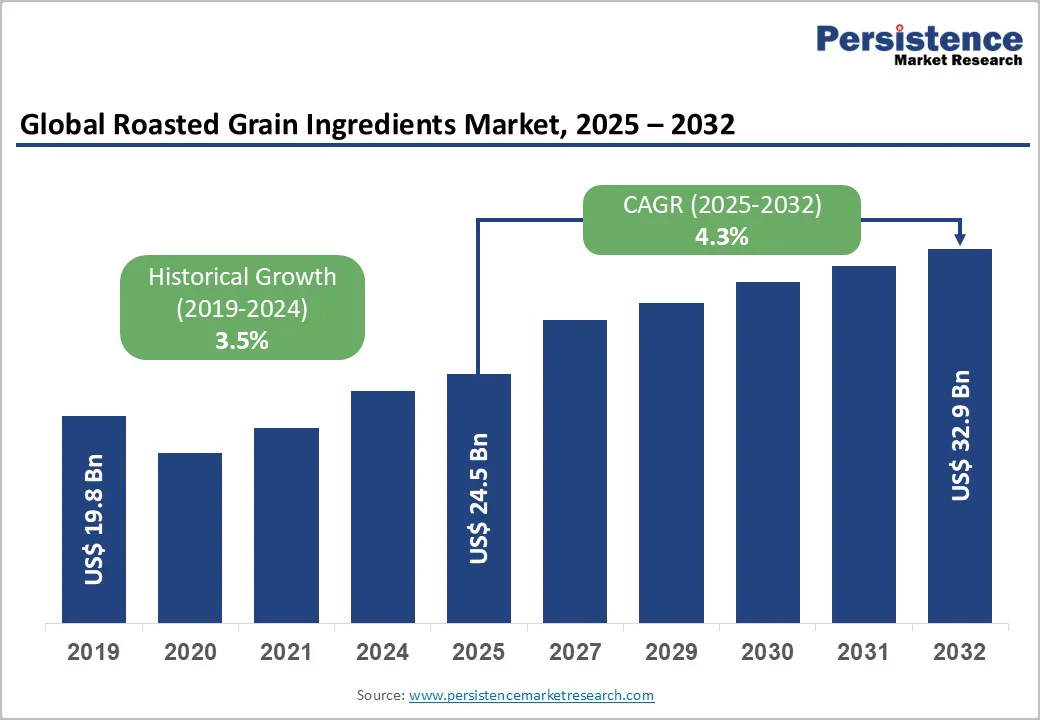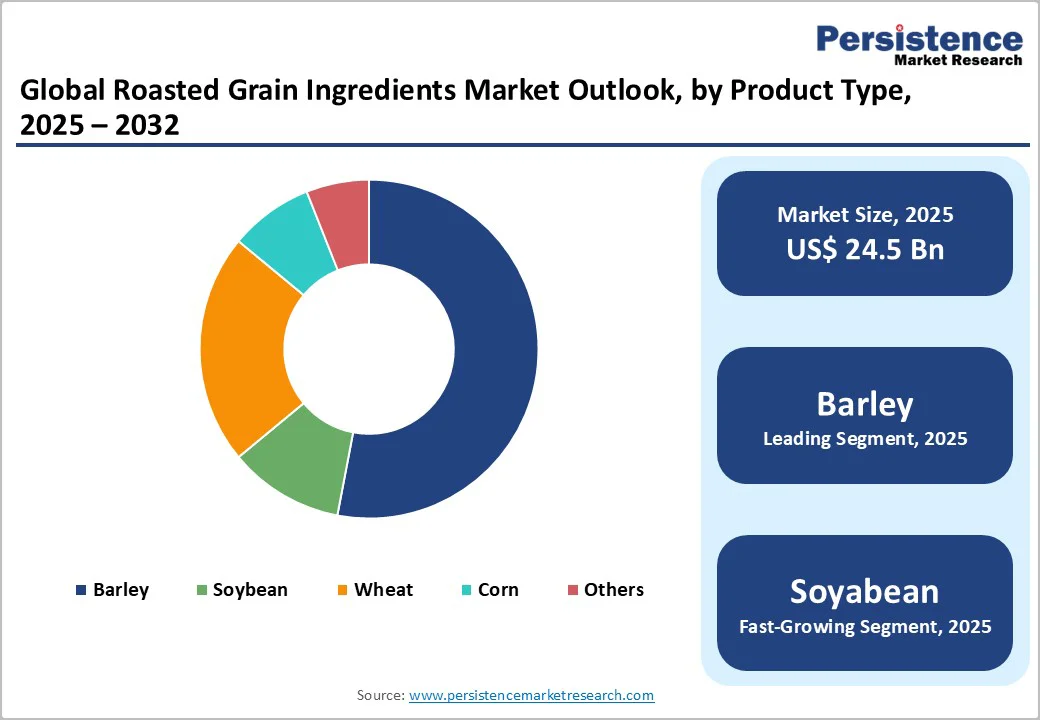ID: PMRREP27910| 195 Pages | 1 Dec 2025 | Format: PDF, Excel, PPT* | Food and Beverages

The global roasted grain ingredients market size is valued at US$ 24.5 billion in 2025 and projected to reach US$ 32.9 billion growing at a CAGR of 4.3% during the forecast period from 2025 to 2032.
The global roasted grain ingredients market is evolving rapidly, driven by the surge in plant-based innovation, sustainable sourcing, and growing consumer preference for authentic, natural flavors. The bakery and food additives industries adapt to clean-label and premiumization trends, and roasted grain ingredients are emerging as essential components for both functional and indulgent formulations across regions.
| Key Insights | Details |
|---|---|
| Global Roasted Grain Ingredients Market Size (2025E) | US$ 24.5 Bn |
| Market Value Forecast (2032F) | US$ 32.9 Bn |
| Projected Growth (CAGR 2025 to 2032) | 4.3% |
| Historical Market Growth (CAGR 2019 to 2024) | 3.5% |

High demand from craft brewers is expected to drive the growth of the global roasted grain ingredients market. Roasted malt offers a variety of tastes, textures, and flavors to beer, which boosts its appeal among craft brewers. Craft brewing has become very popular among consumers because it provides diverse qualities and flavors at competitive prices.
Craft brewers are eager to deliver a better beer experience and are inclined to use roasted barley and wheat malt. Roasted malt can produce different colors and flavor profiles in the final product, helping brewers enhance their product quality.
Additionally, the presence of flavors such as chocolate, coffee, caramel, and others makes roasted malt very appealing to brewers. For instance, Proximity Malt, a leading malt producer in the United Kingdom, offers a range of roasted malt products for craft and home brewing.
Volatile climatic conditions have emerged as a significant disruptor to the global roasted grain ingredients market, driving irregularities in grain supply and price fluctuations. Erratic rainfall patterns, prolonged droughts, and extreme weather events are impacting key grain-producing regions, leading to inconsistent crop yields and reduced availability of quality raw materials.
Manufacturers face rising production costs as they struggle to secure stable grain supplies for malted barley, wheat, and other roasted varieties. This cost pressure often cascades through the value chain, influencing pricing strategies and profit margins. Additionally, uncertainty in global grain trade due to shifting weather zones and geopolitical disruptions further intensifies the challenge, restraining scalability and long-term investment confidence among producers.
An emerging opportunity in the global roasted grain ingredients market lies in leveraging roasted aroma profiles to enhance feed palatability. Controlled roasting unlocks complex Maillard reaction compounds that improve flavor depth, aroma, and texture appeal in animal feeds. Livestock and pet nutrition manufacturers are exploring these ingredients to boost feed intake, reduce waste, and improve overall animal performance.
Startups and ingredient formulators can differentiate through precision roasting technologies that customize aroma intensity based on species preference. As consumer expectations for animal welfare and natural feed additives rise, roasted grains with optimized sensory characteristics present a compelling value proposition bridging functionality, sustainability, and sensory science in next-generation feed formulations.
Barley holds approx. 53% market share as of 2024, maintaining its dominance in the global roasted grain ingredients market due to its balanced flavor profile, versatility, and strong demand in brewing, bakery, and plant-based applications. Its high enzyme activity and appealing roasted aroma make it a preferred choice for malt-based beverages and flavor enhancers.
Soybeans are gaining traction for their protein density and nutty roasted character in nutritional blends. Wheat continues to see consistent use for its mild taste and smooth texture, ideal for baked goods and breakfast cereals. Corn, with its caramelized sweetness when roasted, finds rising application in snack coatings and flavor bases, widening its utility across the global processed food segment.
Organic roasted grain ingredients are projected to grow at a CAGR of 5.8% during the forecast period in the global roasted grain ingredients market, driven by the surge in clean-label demand and consumer trust in traceable, chemical-free sourcing. The expanding organic certification network and stricter food safety standards are encouraging food and beverage manufacturers to reformulate with certified organic grains such as barley, wheat, and corn.
Consumers associate organic roasting with richer aroma, higher nutrient retention, and better digestive compatibility, aligning with the broader move toward mindful consumption. Growing retail penetration of organic snacks, malt-based drinks, and bakery items further amplifies this trend, positioning organic roasted grains as a core ingredient in premium and sustainable food innovation.

The North America roasted grain ingredients market is undergoing a phase of transformation as consumers increasingly seek plant-based, functional, and authentic flavor solutions. In the U.S., ingredient producers are partnering with craft brewers and alternative beverage makers to integrate roasted barley and wheat derivatives that deliver richer sensory experiences and improved nutritional value.
In Canada, food processors are incorporating roasted grain flours into bakery and snack formulations to enhance aroma, color, and texture naturally. Established players such as Briess Malt & Ingredients Co. and Siemer Milling Company are strengthening production networks, while emerging startups emphasize artisanal roasting precision and regenerative grain sourcing.
The region’s broader shift toward premium, transparent, and sustainably processed ingredients continues to drive product innovation and differentiation.
Asia Pacific Roasted Grain Ingredients Market is expected to grow at a CAGR of 6.3% driven by rising demand for functional beverages, traditional flavor innovation, and clean-label nutrition. In China, roasted barley and buckwheat are increasingly used in tea blends and wellness drinks appealing to health-aware urban consumers.
India is witnessing demand from breakfast cereal and snack manufacturers incorporating roasted millets and grains for enhanced texture and aroma. Japan and South Korea are advancing the use of roasted rice and barley in caffeine-free beverages and confectionery products.
Local players are investing in advanced roasting technologies and fermentation-based flavor enhancement. The region’s shift toward healthier lifestyles and authentic, grain-derived taste experiences continues to define product development strategies across categories.

The global roasted grain ingredients market is moderately fragmented, shaped by a mix of established ingredient producers and agile startups innovating around sustainable sourcing and advanced processing. Leading manufacturers are expanding roasting capacities, integrating vertically to secure quality raw materials, and investing in cleaner heat-treatment technologies to preserve nutritional value and aroma.
Startups are leveraging organic farming partnerships and precision roasting systems to achieve consistency and flavor differentiation. Certification programs emphasizing organic, non-GMO, and allergen-free claims are gaining importance as transparency becomes a key purchasing factor.
The market is increasingly defined by traceable supply chains, energy-efficient processing, and proprietary roasting profiles tailored for beverages, snacks, and functional foods targeting wellness-conscious consumers globally.
The global roasted grain ingredients market is valued at US$ 24.5 Bn in 2025.
Rising consumer demand for roasted grain-based beverages is fueling growth and expanding opportunities in the global Roasted Grain Ingredients market.
The global roasted grain ingredients market is poised to witness a CAGR of 4.3% between 2025 and 2032.
Enhancing feed palatability through the use of roasted aroma profiles presents a significant growth opportunity in the market.
Major players in the global Roasted Grain Ingredients market include Boortmalt, Malteurop Group, SunOpta Inc., Muntons Malted Ingredients Inc., Bairds Malt, Castle Malting, and others.
| Report Attribute | Details |
|---|---|
| Historical Data/Actuals | 2019 - 2024 |
| Forecast Period | 2025 - 2032 |
| Market Analysis | Value: US$ Bn |
| Geographical Coverage |
|
| Segmental Coverage |
|
| Competitive Analysis |
|
| Report Highlights |
|
By Product Type
By Nature
By Form
By End-user
By Region
Delivery Timelines
For more information on this report and its delivery timelines please get in touch with our sales team.
About Author